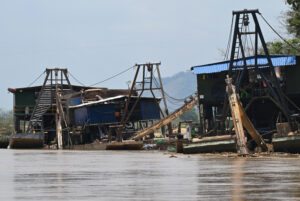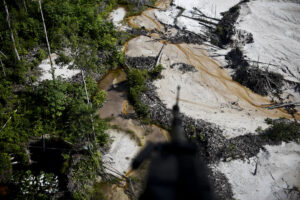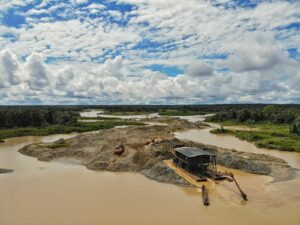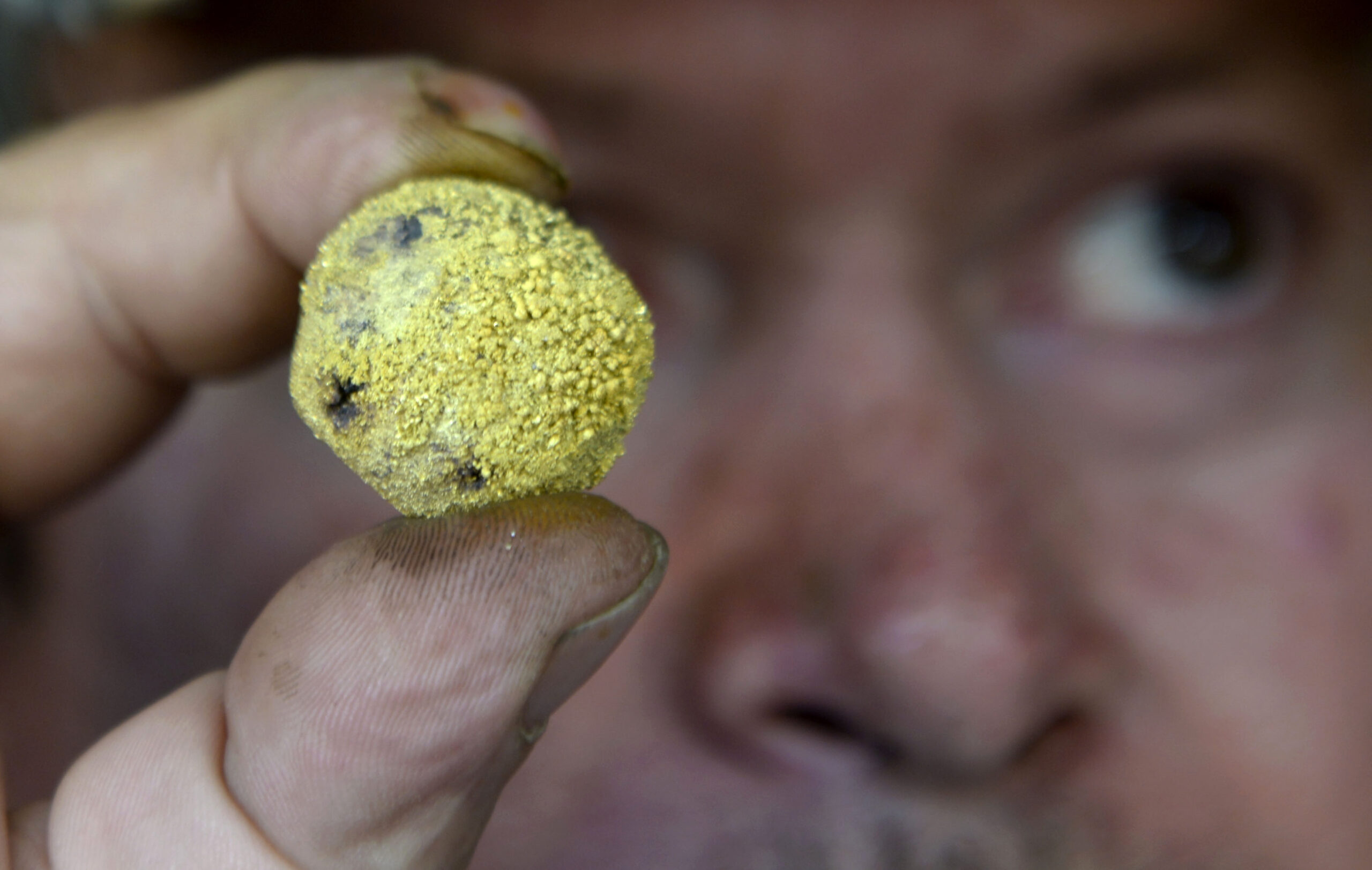Colombia is currently the 16th largest gold producer worldwide and the third largest in Latin America, according to the Statista world ranking. In 2022 alone, the country exported 70.7 tons of gold worth $2.9 billion, according to figures from Colombia’s National Mining Agency. Following oil, coal, and coffee, gold is Colombia’s fourth largest export product.
The price of gold increased in recent years. Its value in the international market went from $340 per ounce in March 2013 to $1,912 in late March 2023. In other words, in just a decade, gold’s value increased by 560 percent. At the same time, demand also increased and reached its highest point in 2022, according to data from the World Gold Council.
These figures could be excellent news for any mining country, but since all that glitters is not gold, for Colombia it represents an enormous challenge. The illegality surrounding gold production, driven mainly by criminal groups, dulls the shine of Colombian gold, making it a threat to national and international security and the environment.
Gold in the hands of illegal armed groups
The increase in the price of gold has become an attractive business for illegal armed groups that have seen gold exploitation and export as a great opportunity to finance their illegal activities.
According to experts, groups made up of former paramilitaries, so-called guerrilla dissidents, and common criminals are acquiring millions of dollars in income with the precious mineral to finance their criminal activities while unleashing high levels of violence among miners and inhabitants, in addition to having a very worrisome environmental impact.
In mid 2022, Colombia’s Office of the Comptroller General, the state’s highest fiscal control body, sounded the alarm when it stated that 85 percent of the gold exported by Colombia is the product of illegal mining. The figure is unsettling, especially given the high presence of armed groups in areas where Colombian gold is extracted, a fact that authorities and investigators are well aware of.
Leonardo Güiza Suárez, director of the Center for Mining and Environmental Innovation at Del Rosario University in Bogotá, told Diálogo that “there groups are not present in only two of the estimated 350 municipalities where gold is extracted: These are California and Veta in the Santander department. The rest are under the control of the guerrilla group [National Liberation Army], guerrillas dissidents [of the Revolutionary Armed Forces of Colombia], and dissidents of the former paramilitaries, who make up the so-called United Self-Defense Forces of Colombia and are known as the Clan del Golfo.”
Colombia’s Office of the Inspector General, which in addition to investigating irregularities by public officials and private individuals exercising public functions acts as guarantor of the collective rights of citizens, corroborates the situation. “In Colombia there are five departments that stand out for illegal mining, these are Cauca, Antioquia, Bolívar, Valle del Cauca, and Chocó, and these are the territories with the greatest presence and incidence of armed groups,” Environmental Prosecutor Gustavo Guerrero told Diálogo.

It is also striking that illicit crops are also present in gold mining areas. “Of the 101 municipalities where there is alluvial gold — which is extracted from open-pit sands and gravels — 70 reported [having] coca crops,” Sandra Rodríguez, a satellite imagery analyst with the United Nations Office on Drugs and Crime (UNODC), told Diálogo.
This whole scenario is attributed to the expansion of illegal mining at the hands of criminal groups. The phenomenon is so serious that experts, officials, and international organizations claim that this activity has replaced cocaine trafficking as the chief mean of support and driving force behind armed groups’ criminal activities.
For the Ombudsman’s Office, gold as a criminal activity is overflowing and the illegal armed group that has benefited the most is the Clan del Golfo. “This organization has grown stronger; in only eight months they went from having presence and control of 12 to 20 departments in the country and in most of them there is gold,” Colombia’s Ombudsman Carlos Camargo Assis said. “The expansive and extortive capacity of the Clan del Golfo is such that it has affected the operation and security of several mining multinationals that have a presence in the country,” he added.
High profitability, low risk
Gold has become the most sought-after financing activity for criminals and armed groups, due to the unquantifiable profits they obtain from its extraction and illicit commercialization, as well as the low risk it entails compared to other illegal activities.
According to figures from the Office of the Comptroller General, while a kilogram of coca on the Colombian market reaches close to $1,150, a kilogram of gold exceeds $57,000. In other words, gold is up to 50 times more profitable than cocaine. “This business is skyrocketing. Illegal mining brings more money than coca; there is no doubt that gold beat cocaine,” mining expert Güiza said.
The illegal profits are alarming. According to a UNODC report, Colombian armed groups get around $1.9 billion each year from cocaine exports, that is 35 percent of their income from illegal gold, which according to data from the Ombudsman’s Office reaches an estimated $3 billion annually, practically the same income that Colombia reported for its gold exports in 2022, for a value of $2.9 billion.
Undoubtedly, the rise in the price of gold can explain the boom in illegal mining within illicit economies, but other reasons also make it a less risky product than cocaine and therefore more attractive.
“Firstly, illicit extraction is seldom punished, it’s an offense for which one can get jail time, while coca has extradition,” Güiza said. “Secondly, gold is not an illegal product in itself. Anyone can carry 3 grams of gold in their pocket without this being illegal activity, while 3 grams of cocaine is a crime. And, thirdly, gold is tremendously susceptible to money laundering. Armed groups sell coca and with that money they buy gold, gold is legal. About 50 different forms of money laundering through illegal gold mining have been identified […]. The business is not to traffic gold, the business is to launder with gold,” Güiza added.
Now, how can money be laundered with gold? According to the Colombian Attorney General’s Office, one of the main means is through the creation of front companies, such as the creation of international trading companies for gold export.
“Through these trading companies, documents are falsified to certify the origin of the gold. The illegally extracted gold is passed off as gold produced by artisanal miners — to whom the law grants the right to sell 420 grams per year for their subsistence — but we’ve established that the alleged artisanal miners from whom they bought it died before the alleged negotiation or simply never existed,” Luz Ángela Bahamón, deputy prosecutor for Criminal Finances of the Attorney General’s Office, told Diálogo. “They also use mining titles that correspond to mines in disuse, that have been closed down, or that have not yet entered into production,” Bahamón added.
“Through this illicit activity criminal groups get sums of money in the multimillions that are channeled through foreign currency by intermediaries in the exchange market, on occasion through exports made, and that give it a semblance of legality,” Bahamón said. “Since 2022 we have charged 42 people for money laundering through illegal mining for a value of some $3.5 billion,” Prosecutor Bahamón said.

In addition, the progress made in the fight against narcotrafficking has led criminal groups to turn their attention to other illicit goods. This is highlighted in a UNODC report, which recognizes that the achievements of the Colombian state in its fight against narcotrafficking have increased the costs and risks associated with this activity. “This has forced criminal groups to reorient their sources of financing in search of illicit markets where it is more difficult to follow the trail and where they are more profitable. If they are willing to change drug trafficking routes, they are also willing to replace the merchandise,” Güiza said.
This is not to say that no measures have been implemented, nor are great efforts being made to combat illegal mining. In early 2021, the Colombian Military Forces launched the Command against Drug Trafficking and Transnational Threats (CONAT), a specialized unit to combat cocaine production, illegal mining, and the armed groups that carry out these activities.
The Carabineros and Environmental Protection Directorate (DICAR) of the Colombian National Police also combats this crime, and according to figures provided to Diálogo in 2022, authorities carried out 578 operations and seized 65 kilograms of gold, representing a value of $3.8 million.
However, operations to dismantle illegal mining are far more complicated than coca eradication efforts, and this has undoubtedly made illegal mining more likely. “It takes a lot of money, helicopters, and heavy artillery to dismantle a mine. Most of the mines are in jungle locations very difficult to access; it’s very complex,” Güiza said.
Booming business: Mercury, fees, and other illicit activities flourishing alongside illegal gold
In addition to the high revenues criminal groups receive from illegal gold, there are other juicy activities that, along with illegal extraction, are enriching these criminal groups, while destroying forests, contaminating rivers, devastating ecosystems, thus impoverishing Colombia.
One of them is mercury smuggling. This indispensable element for gold extraction was banned in Colombia in 2018. However, it continues to be used as if there were no restrictions whatsoever. Its illegal import has been growing in recent years at the hand of criminal gangs that control the illegal gold market. “They import it mainly from Mexico, which is the largest producer of mercury, and they do it through the same pipelines they use to export coca. It’s an exchange of goods,” Güiza said.
According to data from the United Nations Environment and Development (UNED) program, Colombia has the highest mercury emissions per capita worldwide and is the third country that pollutes the most with this mineral after China and Indonesia, emitting approximately 75 tons per year of the mineral into the environment.

“Illegal mining is the biggest cause of this scourge and it’s wiping out our country’s water sources,” said Environmental Prosecutor Guerrero. “Approximately 1,150 water sources cross municipalities where illegal gold mining takes place, and of these 232 water sources pass through municipalities where cases of mercury poisoning have already been detected.”
Among the most affected groups are children in early childhood. A study carried out by the National Institute of Health concluded, after evaluating 150 nursing mothers in gold-producing municipalities, that 39 percent of them had elevated mercury concentrations. “This is a very serious health impact. Mercury increases the chances of developing neurological disorders and complications in intrauterine development and in the early stages of life,” Guerrero said.
Added to this unfortunate environmental impact is the cultural and economic effect of mercury contamination. Another study, also carried out by the National Health Institute, found that of 45 fish species studied in Ayapel, Córdoba department, 42.2 percent exceeded the maximum concentration allowed by the World Health Organization. “Mercury is generating a crisis for populations whose food and livelihood is fish. They no longer consume fish, much less sell it,” illegal mining expert Christoph Kaufmann, lead researcher of the Jurisprudence Faculty of the Del Rosario University in Bogotá, said.
The situation is so worrisome that the Attorney General’s Office, with the support of the U.S. State Department, convened in January 2023 the first National Roundtable to address this socio-environmental crisis. “We are building territorial mercury control tables and carrying out field work in order to present a diagnosis and take urgent action measures,” Guerrero said.
Enriching fees and destructive machines
Another way to get illicit profits is through the “fees,” “taxes,” or sums of money that armed groups arbitrarily charge to whoever wants to participate in gold exploration in areas under their control. “There are thousands of families in Colombia who make a living from artisanal mining, but armed groups extort money from them so that they can carry out their activities and in this way earn a percentage of the production,” Kaufmann said.
According to the Organization of American States report, Illegal Mining: The Case of Colombia, criminal groups are reportedly earning between 5 and 10 percent of gold production through these levied fees. However, the report also highlights that while extortion has long been a method employed by these criminal groups, they are increasingly becoming directly involved in illegal mining activity.
Another method of enriching themselves is through illegal import and sale of heavy machinery required for gold extraction. “There is no doubt, we are seeing more and more how these groups are raising funds to get backhoes and other equipment, including explosives needed for the illicit extraction with which they are ravaging our country’s forests,” Kaufmann added.
Colombia’s Institute of Hydrology, Meteorology, and Environmental Studies highlighted that 174,104 hectares of forests were cleared in 2021, or 2,419 hectares more than the previous year. While not all deforestation is the result of illegal mining, a high percentage is. “As far as alluvial mining is concerned, 71 percent of forest and vegetation losses coincide with territories illegally exploited,” Rodríguez, the UNODC analyst, said.
This is a very alarming situation given that the country’s largest ecosystem is being destroyed. According to Rodríguez, “99 percent of the illicit exploitation of alluvial gold is located in forest reserve areas.”
“These are areas with high biodiversity that have already lost all capability for the soil to recover. This is of great concern because they will never again provide the same ecosystem services,” Rodríguez added.
In addition to environmental impacts, there are other crimes that violate human rights, such as human trafficking. “Around mining there is a very broad criminal chain, not only is there the production and sale of gold or inputs related to this illicit activity, but there is also prostitution and forced labor, even of children. Human trafficking is the third source of financing for illegal armed groups and they take advantage of this land to grow their business,” Ombudsman Camargo said.
Controlling the lack of control
Knowing with certainty where the gold that Colombia sells to the world comes from is a great challenge. Not only the precious metal traded in the domestic market, but also the one that the country exports. In the end, this metal is used without really knowing in whose hands it was or how it was extracted.
One only has to review some shocking figures, such as the marked difference between gold production and exports. In 2021, according to data from the National Mining Agency, 55.3 tons of gold were produced, but 79.4 tons were exported. Where did the remaining 24.1 tons come from?

According to U.S. think tank Global Financial Integrity (GFI), which specializes in illicit financial flows, between 2010 and 2018 the exports reported by Colombia, versus the imports reported by the countries with which gold is legally traded, do not match and leave a gap of $5.6 billion — money not reflected in the national income and that most likely remained in the hands of illegal actors.
The New York Times documentary series The Weekly exposes how illegal gold is more difficult to trace than other commodities such as diamonds and drugs, and points to Colombian gold in particular. The documentary exposes the case of motherboards, which are indispensable for the use of cell phones, and stresses that gold is needed for them to work. Gold, which according to The Weekly comes in many cases from illegal mining. However, no one knows it.
The situation is so complex that the financing of armed groups’ illicit activities in Colombia through illegal gold mining has even been compared to Angola’s dirty diamonds and jade mining in Afghanistan.
The traceability of gold operations is a challenge for Colombia. The illegality and criminality surrounding the gold market has led to a lack of control over the production and commercialization of this metal, generating a threat to international security as it is a source of financing for illegal armed groups.
Given the urgency to attack this scourge, the National Mining Agency together with the Ministry of Mines and international entities such as the Inter-American Development Bank (IDB) and the Organization of Ibero-American States (OEI) have joined forces to create a platform that allows the traceability, from beginning to end, of the commercial transactions made with gold and determine the legality of its origin.
“A regulatory sandbox is being developed that has no precedent in the mining sector worldwide to know the provenance of the gold that is bought and sold in real time, preventing the manipulation of documents for subsequent export,” José Alveiro Goyeneche, lead analyst of this project, told Diálogo. “What normally happens is that the gold’s provenance is adjusted along the commercial chain to give it the appearance of legality, but with this platform the commercial activities are traced in a database that makes it possible to identify where fraudulent actions are being generated,” Goyeneche concluded.









